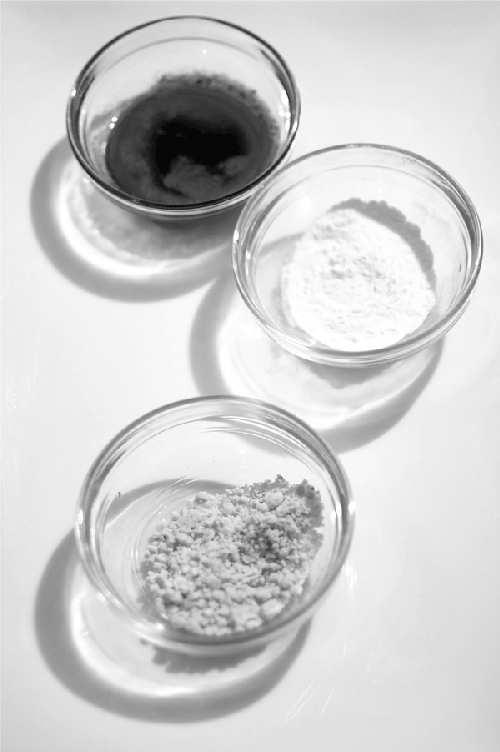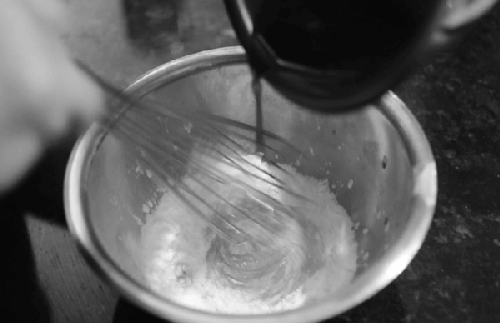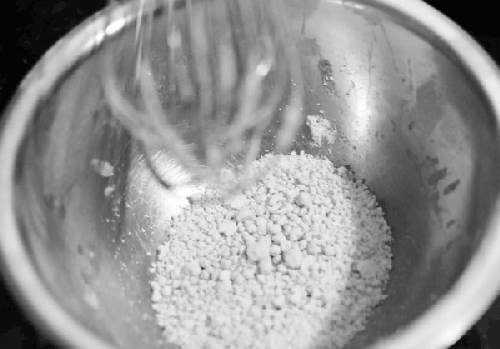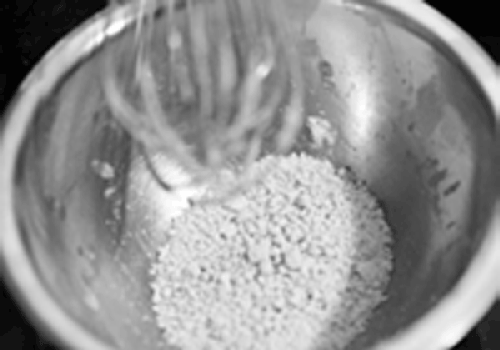4.2. “Melts” in your mouth: Maltodextrin
Maltodextrin—a starch—dissolves in water, but not fat. In
manufacturing, it’s spray-dried and agglomerated, which creates a powder that’s very
porous on the microscopic level. Because of this structure, maltodextrin is able soak up
fatty substances (they won’t cause it to dissolve), making maltodextrin useful for
working with fats when designing food. It also absorbs water, so is used as an
emulsifier and thickener, as well as a fat substitute: once hydrated, it literally
sticks around, mimicking the viscosity and texture of fats.
Since it comes as a white powder, you can also use maltodextrin to turn fatty
liquids and solids such as olive oil and peanut butter into powder. Because maltodextrin
traps oils but dissolves in water, the resulting powder dissolves in your mouth,
effectively “melting” back into the original ingredient and releasing its flavor. Since
maltodextrin itself is generally flavorless (only slightly sweet), it does not
substantially alter the flavor of the product that is being “powderized.”
In addition to the novelty and surprise of, say, a powder dusting on top of fish
melting into olive oil in your mouth, powders can carry flavors over into applications
that require the ingredients to be effectively “dry.” Think of chocolate truffles rolled
in chopped nuts: in addition to providing flavor and texture contrast, the chopped nuts
provide a convenient “wrapper” around the chocolate to allow you to pick up the truffle
and eat it, without the chocolate ganache melting on to your fingers. Powdered products
can be used to coat the outsides of foods in much the same way that chopped nuts are
used to coat the outside of truffles.
Instructions for use. Add powder slowly to your liquid fat for a ratio of about 60% fat, 40%
maltodextrin by weight. You can pass the results through a sieve to change the
texture from breadcrumb-like to a finer powder.
Uses. Industry commonly uses maltodextrin as a filler to thicken liquids (e.g., the
liquid in canned fruits) and as a way to carry flavors in prepackaged foods such
as flavored chips and crackers. Since it traps fats, any fat-soluble substances
can be “wicked up” with maltodextrin and then more easily incorporated into a
product. For experimental dishes, you can use maltodextrin to create powders that
can be sprinkled on the plate as garnish or as a way of transforming something
that’s normally liquid into a solid.
Origin and chemistry. Derived from starches such as corn, wheat, or tapioca. Tapioca maltodextrin
seems to be most commonly used in modernist cooking. Maltodextrin is made by
cooking down the starches and running the resulting hydrolyzed starches through a
spray-dryer. Chemically, maltodextrin is a sweet polysaccharide composed of
typically between 3 and 20 glucose units linked together.
When it comes to understanding how maltodextrin soaks up oils, imagine it being
like sand at the beach. The sand doesn’t actually bond with the water, but it’s
still wicking up the liquid in the space between the granules due to capillary
action. When working with either sand or maltodextrin, with the right amount of
liquid, the powder clumps up and becomes workable. Because maltodextrin is water
soluble, however, water would dissolve the starch granules. And, luckily,
maltodextrin can soak up a lot more oil per volume than sand can soak up water,
making it useful for conveying flavors in a nonliquid form.
Whisking any fat such as
browned butter (upper left) with maltodextrin (center right) creates a powdered form
(bottom) that can be used to create a surprising texture as the powder “melts” back
into browned butter when placed in the mouth. Try using this browned butter powder
as a garnish on top of or alongside fish, or making a version with peanut butter and
sprinkling on desserts.

In a skillet, melt:
4 tablespoons (60g) salted butter
Once melted, continue to heat until all the water has boiled off. The butter
solids will start to brown. Once the butter has completely browned and achieved a
nutty, toasted aroma, remove from heat and allow to cool for a minute or two.
In a small mixing bowl, measure out:
½ cup (40g) maltodextrin
While whisking the maltodextrin, slowly dribble in the browned butter until a wet
sand–like consistency is reached.


Notes
Stir slowly at the beginning because maltodextrin is light and will
easily aerosolize. The ratio between maltodextrin and the food will vary. If
your result is more like toothpaste, add more maltodextrin.
If the resulting powder is still too clumpy, you might be able to
dry it carefully by transferring the powder to a frying pan and applying low
heat for a few minutes. This will help dry out any dampness present from room
humidity. It will also partially cook the food item, which might not work for
powders containing items such as white chocolate.
For a finer texture, try passing the powder through a sieve or
strainer using the back of a spoon.
Try adding a bit of lemon juice to the brown butter, after it has
cooled but before mixing it with the maltodextrin.
Additional flavors to try: peanut butter, almond butter, coconut oil
(virgin/unrefined), caramel, white chocolate, Nutella, olive oil, foie gras,
bacon fat (cook some bacon and save the fat drippings—this is called
rendering). You don’t need to heat the fats first, but it might take a
bit of working to get the maltodextrin to combine. For liquid fats (olive oil),
you will need to use roughly 2 parts maltodextrin to 1 part fat: 50g olive oil,
100g maltodextrin.
